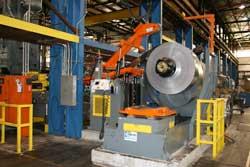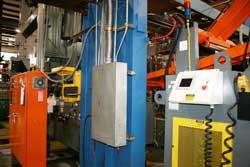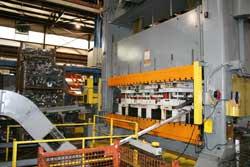- FMA
- The Fabricator
- FABTECH
- Canadian Metalworking
Categories
- Additive Manufacturing
- Aluminum Welding
- Arc Welding
- Assembly and Joining
- Automation and Robotics
- Bending and Forming
- Consumables
- Cutting and Weld Prep
- Electric Vehicles
- En Español
- Finishing
- Hydroforming
- Laser Cutting
- Laser Welding
- Machining
- Manufacturing Software
- Materials Handling
- Metals/Materials
- Oxyfuel Cutting
- Plasma Cutting
- Power Tools
- Punching and Other Holemaking
- Roll Forming
- Safety
- Sawing
- Shearing
- Shop Management
- Testing and Measuring
- Tube and Pipe Fabrication
- Tube and Pipe Production
- Waterjet Cutting
Industry Directory
Webcasts
Podcasts
FAB 40
Advertise
Subscribe
Account Login
Search
Die shop transitions to production stamper
Servo feeds help facilitate transformation, adaptation
- July 29, 2008
- Article
- Bending and Forming

What started as fill-in work for idle tool tryout presses has now become full-time production stamping for this die shop. Advanced feed lines and a multifunction software program helped facilitate the successful transition.
Third-generation tool- and diemakers Tom and Jerry Wysoczynski broke out on their own in 1987 and started up Die-Tech Industries Inc. in Carrollton, Ga. The timing was perfect for the brothers, as the Southeast was becoming a major North American manufacturing region and surrounding industries needed skilled tool- and diemaking shops. It wasn't long before the company was fulfilling some of the region's toughest tooling demands from automotive, appliance, aerospace, and hardware industries and strengthening its reputation throughout the U.S.
"Like every other industry in the U.S. today, tool and die shops have been hit hard by global competition," said Tom Wysoczynski, president and CEO."Margins kept shrinking to the point where, if we were awarded a contract, we wondered where the mistake was made in our quote."
As part of its operations, Die-Tech always had a few presses in-house used to perform die performance trials and runoffs. Then in 1999 the company started accepting production stamping jobs for the presses to fill the idle time between testing and help offset fixed costs.
Soon it became apparent that the company's pneumatic feed presses needed automated feed equipment to keep up with the production pace.
Servo Press Feeds to the Rescue
"We quickly determined that we needed accurate, flexible servo feeds to be competitive both in quality and productivity," said Wysoczynski. Die-Tech purchased servo feeds, coil handling equipment, and straightening systems from Dallas Industries, Troy, Mich.
"The servo feeds' flexibility allowed fast and simple changeovers in the job shop environment," Wysoczynski explained.
"Dallas' feed equipment is tough, reliable, and precise ... letting us run applications that other press feed manufacturers told us couldn't be done," Wysoczynski said.
For example, the stamping of an automotive fan hub must be held flat to 0.005-inch total indicated runout (TIR)."When others said 'no way,' Dallas delivered on a powerful feed and pull-through straightener that resolved the issue," Wysoczynski said. The feed system accurately indexes and straightens the material post-loop (just before die entry), which provides consistent performance to part tolerance specifications.
Most recently Die-Tech has acquired a Dallas Space-Saver™ servo feed. The space-saving feed equipment reduced the amount of floor area required by as much as half compared to the floor space taken up by a conventional feed system layout, according to Die-Tech."Eliminating the cost and need to dig a pit for the material to loop and saving the additional floor manufacturing space that we never have enough of were extremely beneficial to us," Wysoczynski said. Being able to install the line without"roping off" floor space and without disrupting current manufacturing was another reason, he said.
The line comprises three pieces of equipment—a powered reel and load car mechanism; a combination coil restrictor/peeler/threader/debender; and a high-powered single unit combining servo roll feed and pull-through straightener.

Figure 1The touchscreen makes first-time setups simple by guiding operators through the sequential steps, and helps them make adjustments that optimize part quality and productivity.
The line is attached to a 500-ton press with a 132-in.-long bed. It is used primarily for progressive dies with multiple applications of in-die nut and in-die stud staking. The system handles coils weighing up to 30,000 pounds and material widths from as narrow as 12 in. to 36 in., and up to 72 in. diameter. The large coil capacity allows the stamper to make fewer coil changes, which means more uptime and less start-up scrap, according to the company.
Die-Tech now is able to achieve approximate feed and press speeds of up to 83 strokes per minute (SPM) at a 6-in. feed length and 240-degree feed cycle—a significant increase from its pneumatic fed operation.
The company looked to the equipment's automatic, self-centering capabilities to reduce die mis-hits and quality defects caused by the improper die or material setup, Wysoczynski said.
The powered reel is self-centering with a variable-speed, AC drive with a dual-pressure, adjustable air brake; coil width scales on its adjustable arms; hydraulic-powered mandrel expansion and push-button-controlled support arm expansion; and a fail-safe braking system.
Safety was an important consideration for the company also. The combination coil restrictor prevents coil from springing when restraining bands are cut. The peeler lifts the leading edge of material from the coil. The threader guides material edges into the straightener, and the debender helps remove leading and trailing edge bend from coil material.
Accurate Feeds Prevent Mis-hits
As a diemaker, Die-Tech knew the importance of preventing mis-hits, breakage, and unexpected repairs to avoid having to pull out dies, punches, and springs in the middle of a run to replace them or any of the many other components needed to keep presses up and running.
"Accuracy is critical, especially for staking operations," said Wysoczynski."If the location is off just slightly, a mis-hit can cause upwards of $1,500 damage to replace a staking head. One of our jobs is to manufacture brackets for mounting the rear hatch to the body chassis. It has six staking heads to attach nuts to the bracket. An inaccurate feed could cost up to $9,000 to repair the die, plus downtime and labor."
In addition to the feed's pilot pin operation, the straightener unit includes a piloting head that pivots upward to release pressure on the material as the die pilot pins precisely locate the stock. The piloting operation eliminates wear and tear on die components, eliminates the potential for backups and mis-hits, and helps ensure feed accuracy.
Reducing Setups
A second feature of the line is its full-function control system with a new touchscreen interactive programming unit (see Figure 1). The touchscreen feature has slashed setup times, according to Wysoczynski. The control makes first-time setups simple by guiding operators through the sequential steps, and helps them make adjustments that optimize part quality and productivity, he said.
"Once the initial setup is finished, subsequent setups for a repeat job are a snap," he said."They just enter an identifying code or part number, and all line systems are set to predetermined parameters. In less time than it takes to set up the die, the line is ready to go.
"For us, this flexibility and time savings are important, as we often do three to four setups on this line and press in a 24-hour period."
Software Smooths Bumps
Wysoczynski pointed out that making the transition from diemaking to stamping and forming has had its rough spots. One thing smoothing over the rough spots is an extensive historical database and software program that Die-Tech developed for its operations.
"The stamping business grew too fast and our service suffered for it," Wysoczynski said."That's when we generated our own performance-based software package that tracks every level of operation, including die and press maintenance schedules, setup performance, material requirements planning [MRP] status, routing and logistics, downtime, repair mean times, projected run times, and scrap rates.
"The automated management and information system improved quality performance," Wysoczynski said. Operators cannot clock onto a job until they have received the proper training. All quality check sheets are printed electronically so that the team member has the latest copy at all times. The software system controls scrap, sorting results, daily quality bin inventory, rework hours, and training hours. Dock audits and employee training audits are conducted electronically using a wireless scanner, and results of the audits are presented immediately by e-mail to the supervisor of the team member, human resources, and the quality control manager.
"Basically, if we have a defective product, within 10 minutes we know what date, shift, and employee ran the job and the heat of steel used so that we can start an immediate investigation," Wysoczynski said.
"All die maintenance and machine maintenance are maintained on a predictive-type database where data is generated directly from the amount of parts or time. Both machines and dies are maintained using the same database to draw information from. Schedules are created based on the manufacturing use of the tool or machine to minimize maintenance cost and also create a predictive maintenance type of environment," Wysoczynski said.
The Payoff
Today the company draws the main portion of its business from production stamping and assembly, but also upholds the stringent standards of die manufacturing that earned it the stamping business."Die manufacturing continues to be a good income generator," Wysoczynski said.
The effort involved in the transition from die-maker to production stamper and diemaker has paid off."The stamping portion of the business took off," Wysoczynski said."Currently we're running approximately 40 presses ranging from 45 to 800 tons around the clock. We have more than 550 customer dies and tool sets on hand to run on a contract basis.
"Stamping income has soared to levels nearly 10 times that of 10 years ago."
Related Companies
subscribe now

The Fabricator is North America's leading magazine for the metal forming and fabricating industry. The magazine delivers the news, technical articles, and case histories that enable fabricators to do their jobs more efficiently. The Fabricator has served the industry since 1970.
start your free subscription- Stay connected from anywhere

Easily access valuable industry resources now with full access to the digital edition of The Fabricator.

Easily access valuable industry resources now with full access to the digital edition of The Welder.

Easily access valuable industry resources now with full access to the digital edition of The Tube and Pipe Journal.
- Podcasting
- Podcast:
- The Fabricator Podcast
- Published:
- 04/16/2024
- Running Time:
- 63:29
In this episode of The Fabricator Podcast, Caleb Chamberlain, co-founder and CEO of OSH Cut, discusses his company’s...
- Trending Articles
AI, machine learning, and the future of metal fabrication

Employee ownership: The best way to ensure engagement

Steel industry reacts to Nucor’s new weekly published HRC price

Dynamic Metal blossoms with each passing year

Metal fabrication management: A guide for new supervisors

- Industry Events
16th Annual Safety Conference
- April 30 - May 1, 2024
- Elgin,
Pipe and Tube Conference
- May 21 - 22, 2024
- Omaha, NE
World-Class Roll Forming Workshop
- June 5 - 6, 2024
- Louisville, KY
Advanced Laser Application Workshop
- June 25 - 27, 2024
- Novi, MI



























